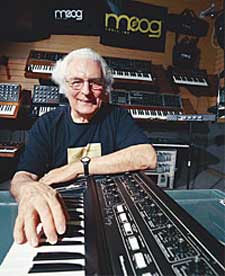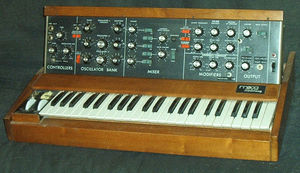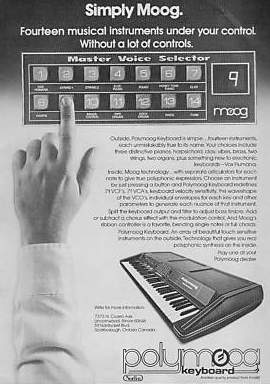Moog
Moog synthesizers are probably the most famous electronic musical instruments of all time. Their designer, Robert A. Moog, was a doctoral student finishing his dissertation at Cornell University in the early 1960s, earning extra cash by selling small numbers of custom-made Theremin instruments. He and a partner were already discussing the possibility of selling other types of electronics kits to hobbyists when he stumbled on the idea of selling custom-made electronic synthesizers.
The idea came in 1963, after Moog was invited to an “experimental” music concert. Inspired, he would subsequently build the first prototypes of what became his signature “modular” synthesizer circuits—electronic oscillators, filters, and amplifiers that operated independently and could be connected together in various configurations to produce sounds. The oscillators produced the basic tones in the form of sine waves, square-waves, or triangular “sawtooth” waves. A keyboard controlled the pitch by sending the oscillator a signal voltage that varied depending on which key was pressed. Then the tones were shaped or through another bank of “filter” circuits to customize the sound or “timbre” of the tone. Finally, the tones were sent to one or more amplifiers to boost them for listening. Demonstrating his prototypes to various musicians and composers, Moog was convinced that he had something really exciting.
Moog proceeded to create a full-scale modular synthesizer that was relatively compact (at least compared to the giant instruments of the 1950s), but highly flexible and adaptable. In October 1964 Robert Moog unveiled his music synthesizer, the Moog Modular System, at the convention of the Audio Engineering Society. The first full-scale Moogs relied on a large number of modules that allowed the musician to shape the sound in an almost infinite number of ways. With a large stack of modules physically “patched” or wired to one another with cords, the whole system resembled a piano strapped to a telephone switchboard.
Eventually, “Moog” became a household word (and people learned that “Moog” rhymed with "vogue"). A flurry of “Moog music” records ensued, many of them of questionable musical quality, but the results were good for synthesizer sales. Moog music reached its peak with the phenomenally successful song "Popcorn," performed by Hot Butter.
The original Moog synthesizer was so large that only a few musicians (such as rock legend Keith Emerson) chose to use it in live performances. However, Moog began work on a smaller version almost immediately, and in 1970 introduced the tiny Moog Minimoog. About that time, he sold his company in order to get out from under a heavy burden of debt. In later years, he continued to act as a technical consultant to Moog Music, Inc., and provided the company with a series of popular keyboard instruments, including the Micromoog, the Polymoog, a Vocoder, and others. Although the company attempted to follow the technological trend and move into the digital synthesizer field, it ran aground in the 1990s and closed up shop. By 2002, Robert Moog had purchased the right to the Moog brand name, and was producing Theremins from his Asheville, North Carolina shop. He was still active at the time of his death in 2005.


